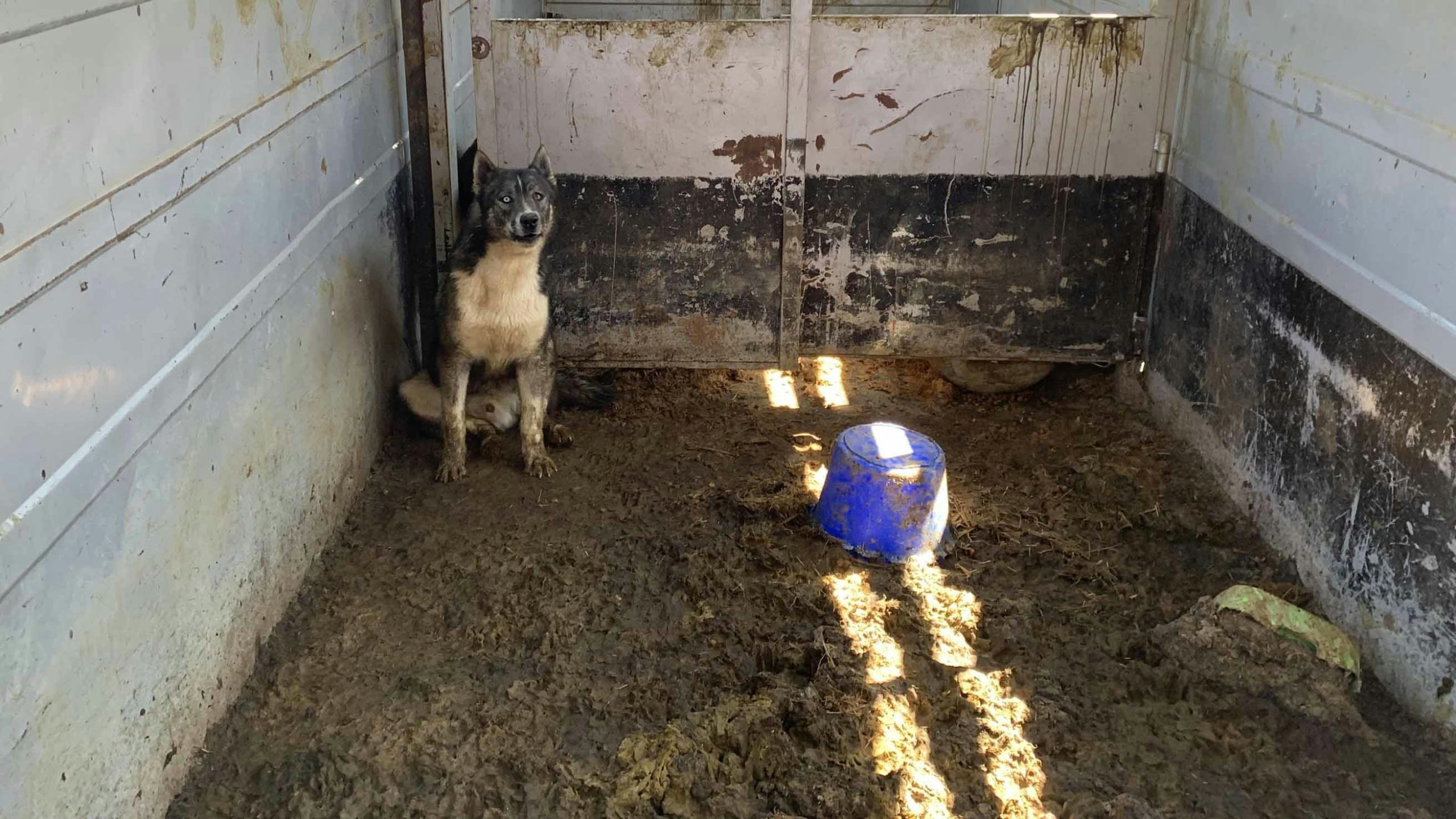A dozen mixed-breed dogs in Big Horn County were rescued Saturday from what one animal rescue expert called one of the “most neglectful situations” he has ever seen.
The Big Horn County Sheriff’s Department announced its active animal cruelty investigation resulted in the discovery of the dogs at a remote residence outside of Lovell. The dogs were surrendered by the owner to the sheriff’s department for adoption.
No charges have been brought against the owner at this time, according to Big Horn County Sheriff Ken Blackburn, who also declined to release the suspect’s name.
“It’s an ongoing investigation, and the case is being moved to the country attorney for review,” he told Cowboy State Daily on Monday.
Blackburn said the sheriff’s office had been investigating the animal owner following several reports of alleged animal abuse dating back to February. Multiple reports indicated that the dogs were being held in an enclosed trailer and moved to different locations.
The most recent report indicated the dogs were being housed on the property outside of Lovell, allowing the sheriff’s office to obtain a search warrant that was executed around 4 a.m. Saturday.
“At the end of the day, it was really good because the owner did relinquish the dogs,” Blackburn said.
The dogs were in various conditions, Blackburn noted, and treated by a veterinarian on scene. To Blackburn’s knowledge, none of the animals had to be euthanized. In total, the department will pay for the vet bills that are estimated to cost between $500 to $1,000, he said.
“Most Neglectful Situation”
John Ramer, executive director of the Kindness Ranch Animal Sanctuary near Hartville, assisted the sheriff’s department in the recovery. He called it one of the “most neglectful situations” he has personally seen.
Ramer got involved in the case after Big Horn County Sheriff Deputy Jeff Angell contacted him about helping his department with the placement of more than 20 mixed-breed dogs in a potential hoarding situation.
The Kindness Ranch only takes in animals rescued from clinical and medical research facilities, though Ramer often helps with rescues by shelters throughout the U.S. in various situations, including natural disasters and occasional neglect cases.
“The mission of Kindness Ranch is narrow in scope, though hearts and reach extend beyond our mission,” Ramer told Cowboy State Daily on Sunday. “It is our philosophy that only working together as a team and lifting each other up will we be successful not just in our mission, but in the overall attempt to end animal neglect and cruelty.”
His team took four of the dogs back to Kindness Ranch on Saturday, where they were cleaned and medically evaluated before being placed in foster care with volunteers and shelters in Cheyenne and elsewhere.
Ramer praised Angell’s diligence and persistence in the investigation.
“He (Angell) ultimately is solely responsible for changing the lives of these canines,” Ramer said.


Vague Laws
Ramer said that despite Angell’s extraordinary work on the case, the sheriff’s department was hindered by budget and resource limitations, as well as vagueness in the existing animal cruelty laws.
“The problem is not the effort, it is the resources to enforce,” Ramer said. “Not just financial and housing resources are needed, but more clearly defined laws regarding cruelty and neglect.”
State laws in hoarding situations vague in defining what specifically constitutes animal cruelty and neglect, Ramer said.
“In the words of one deputy, ‘As long as the dogs have food, shelter and water, there just isn’t much we can do,” Ramer said. “This is vague and inadequate as it calls on the officers to interpret the regulations in what meets the minimum in the eyes of the law and what actually constitutes neglect.
“Nearly 20 dogs locked in horse trailers living in their own feces is disgusting, though according to the law as loosely interpreted by an officer, they had food, shelter and water,” he continued. “For most people, this was very clearly a terrible case of neglect, but the owner of the dogs claimed she was caring for them. So how do we enforce this? Where is the line that separates interpretation and enforcement?”
Blackburn agreed the way the statutes are written can make it difficult to assign the appropriate charges.
“We have the burden of proof that needs to be beyond a reasonable doubt,” he said. “Some of the animal statures have made it difficult in certain situations.”
Along with more clearly worded laws, Ramer said counties should have better shelters set up for emergency housing of animals displaced by natural disasters and criminal seizures.
“This should not be up to the dedicated work of volunteers or nonprofits who have to constantly fundraise,” Ramer said. “Your local nonprofit doesn’t have the authority to seize animals who suffer neglect and abuse; your local law enforcement agency does but doesn’t have the resources. By bridging this gap, we can make our local communities a happier, healthier place to live for all.”
Neglect Cases Predicted To Get Worse
Blackburn has been involved in a few animal hoarding cases throughout his career, including one involving the rescue of more than 100 horses and about 60 dogs.
Much like in this recent case, Blackburn said that in his experience, the animal owners aren’t “twisted,” but rather are people with good intentions who get overwhelmed and don’t know how to fix the situation.
This is compounded by harsh economic times, particularly with skyrocketing hay and food prices.
“We are going to see more of this as we go,” he said.
Regardless of intentions, animal cruelty is nonetheless a crime, Blackburn noted.
“It’s our job to protect not just the people, but the animals as well,” he said.
Ramer said his organization was happy to be able to help in this rescue.
“The ability to assist law enforcement in this case, in our home state, was an honor and wonderful chance to work locally and make a difference in the lives of these beautiful dogs,” he said.





